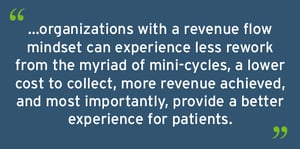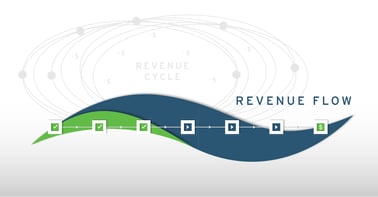Recently, I shared a blog post that challenged healthcare leaders to stop thinking about the reimbursement process as a revenue “cycle.” Rather, I recommend organizations start thinking about this process as a revenue flow – a straightforward sequence of events for reimbursement with no backtracking to redo, resend, appeal, reverse, or change claims.

Why? Because I’ve witnessed how organizations with a revenue flow mindset can experience less rework from the myriad of mini-cycles, a lower cost to collect, and more revenue achieved. Most importantly, it allows them to provide a better experience for patients.
Here’s how: If all the steps in the revenue cycle worked correctly the first time, then the entire process would be considered more of a revenue flow. That straightforward sequence of events in the revenue flow could become a repeatable process without the delay and rework from the multitude of inherent mini-cycles.
You may have read my first post and thought the concept sounded great in theory, but it wasn’t practical. No matter how hard we try to avoid it, mini-cycles and rework will always exist. And aside from that, it would be a tall order to get everyone on board with adopting a revenue flow mindset across your organization.

We hear you. And we understand. We’re promoting a new way of thinking about a reimbursement model that’s been around for decades. We’ve all become somewhat accepting that there will be some disconnects and rework. But should we? Why shouldn’t we strive for that fully streamlined revenue flow?
If you agree that this process could be better – for our health systems and our patients – then it’s time to look at what we can do differently to obtain different results. Below, I share four steps you can take to begin to establish a more efficient revenue flow at your organization.
1. Identify front-end, root-cause accuracy issues
An efficient revenue flow starts with your organization’s front-end functions. The more accurate you are during this process, the better. We recommend asking some essential questions to determine areas for improvement on the front-end:
- Are there ways to enhance the patient scheduling process?
- Do gaps exist in patient registration and eligibility checks?
- What happens with referrals?
- Do you know where your referral leakage is? Even inside your organization? Are there referrals that never get completed?
- Are patients being routed to the right place of service (inpatient or outpatient)?
- Do front-end staff have the tools they need to identify and collect co-payments and deductibles at the point-of-service?
- Does the scheduler and eligibility/coverage intake area have access to understand the contracts and benefit coverage?
- How well can costs be described to patients when they ask what it will cost them?
- How many “touches” does the patient have to receive in your organization just to access care?
- How easily can patients get their questions answered?
- What happens if the patient does not readily have the right information needed?
If you have a streamlined process in place that helps you answer each of the questions above, you’ll likely increase the accuracy of your claims and ultimately drive greater efficiency throughout your revenue flow. The areas referenced above have a significant impact on the accuracy and completeness of the patient account, which will be used throughout the process flow for each patient.
2. Identify gaps to increase accuracy of documentation, coding, and charging processes
In the middle of the revenue flow, information is compiled and added to the patient’s medical chart. The quality and accuracy of this information will ultimately impact the net revenue to your organization. That’s why it’s critical to get this information right the first time around. And if a patient’s services were not documented, you have no hope of getting any reimbursement.
Below are some key questions that will help you identify areas of improvement within your documentation, coding, and charging processes:
- Are there deficiencies in the documentation for services performed?
- Is it very clear what services' codes should be charged? Each and every time?
- What metrics are in place to identify gaps, trends, or nuances?
- How do the providers feel about the current process?
- Is there a QA process in place?
- Does a feedback process exist?
- Does the feedback process work?
- What reports are available for QA review and reconciliation?
- If you were to select a physician today and ask his/her thoughts about the charging process, what would he/she say?
3. Enhance collaboration between front-end, middle-space, and back-end teams
Collaboration is a vital component of any successful organizational process, and your revenue process flow is no exception. Often, when we start working with an organization, we’ll notice there is limited interaction between front-end, middle-space, and back-end functions. Even the reporting of metrics across departments may be limited.
One reason for this is that the revenue flow is a complex process involving multiple departments and generally hundreds of people within an organization. Each role and function are, by nature, very segmented. Teams are generally only familiar with the tasks associated with their own department’s individual roles. However, limited interaction between these functions can lead to breakdowns in the reimbursement process.
To help avoid these breakdowns, we suggest looking for opportunities to improve communication and increase interaction between these functions. Help each team and individual understand how their role fits into the larger reimbursement process. Also, strive to give these teams regular visibility into big picture performance by sharing metrics that show how your organization is tracking against its goals.
Shared knowledge is critical to establishing trust and building better collaboration among your teams. Think about ways you can enhance communication to these teams, leveraging the appropriate channels and opportunities for education at your organization.
4. Develop ongoing education and training
Speaking of education, training and education programs tend to take a back seat when it comes to organizational priorities. Yet, in an industry where workflows change and systems are updated regularly, education should be at the very top of your priority list.
Effective, ongoing education helps keep staff apprised of technology updates, workflow enhancements, or any other information they need to be aware of to effectively do their job. Education also leads to greater knowledge-sharing, giving staff a general sense of how the revenue process works and how their role fits into the overall revenue process flow. These are also essential components of enhancing collaboration between functions, which I discussed above.
With the right education and training strategy around your reimbursement process, your team members will continue to grow and develop in their roles. They’ll also have a better understanding of any issues to flag throughout the revenue flow process, and the key questions to ask along the way.
Sometimes we need a healthy disruptor to start seeing better results. By taking these initial steps toward establishing an efficient revenue flow, you may start to experience these better results – increased efficiency, decreased avoidable losses, and a better patient experience.
If you’d like to discuss how to help your organization take on a revenue flow mindset, please let us know. Schedule a meeting so we can learn more about your organization’s specific revenue needs. We can help tailor the right approach for your organization considering where you are today, and where you would like to take your organization in the months ahead.
Cathy Smith is the practice leader and managing director of Nordic's revenue cycle transformation practice. She served as managing director of The Claro Group's revenue cycle transformation practice (now part of Nordic) since 2011. With over 25 years of healthcare experience, Cathy is a nationally-recognized expert in the areas of healthcare operational and financial management, patient financial services, and information technology.

